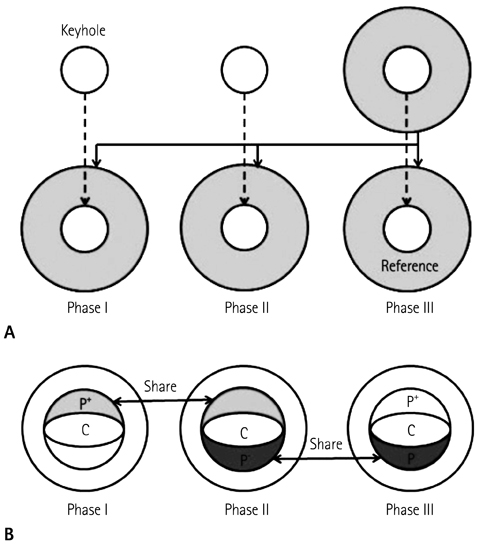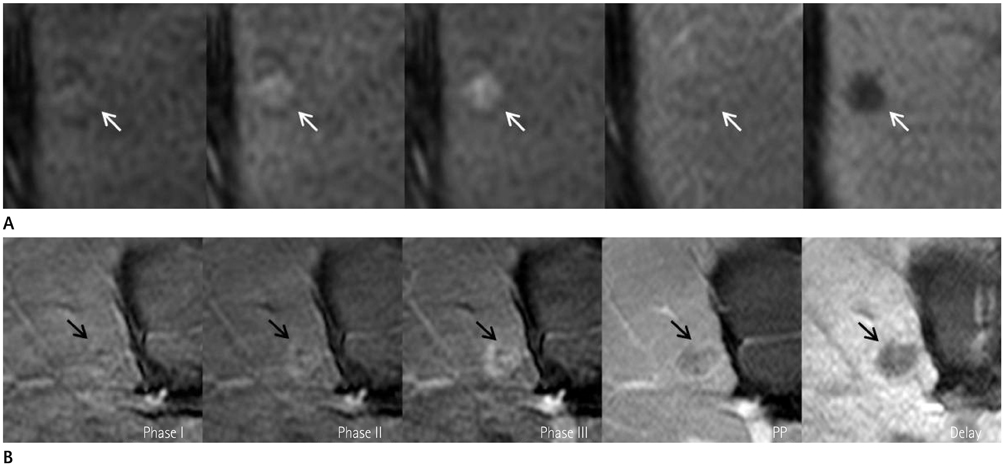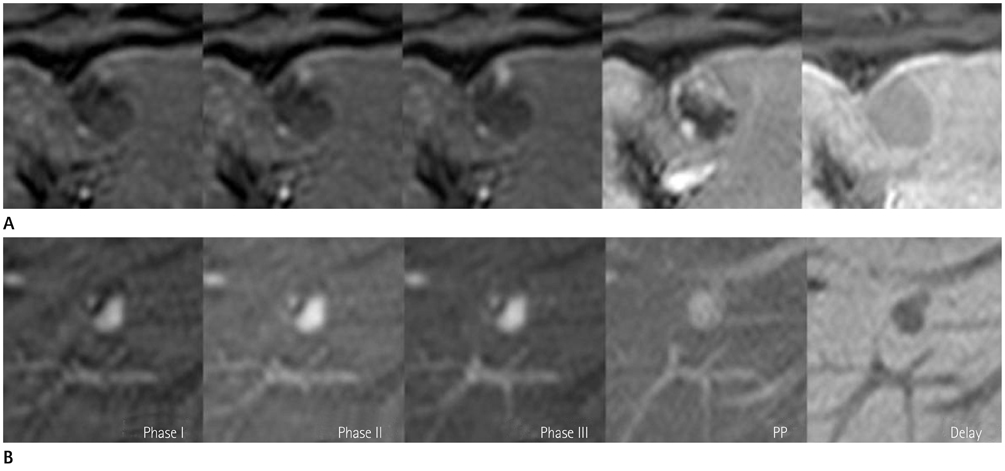J Korean Soc Radiol.
2013 Sep;69(3):223-234. 10.3348/jksr.2013.69.3.223.
Triple Arterial Phase Hepatic MRI Using Four Dimensional T1-Weighted High Resolutions Imaging with Volume Excitation Keyhole Techniques: Feasibility and Initial Clinical Experience in Focal Liver Lesions
- Affiliations
-
- 1Department of Radiology, Anam Hospital, Korea University College of Medicine, Seoul, Korea. dr.minjukim@gmail.com
- KMID: 2208805
- DOI: http://doi.org/10.3348/jksr.2013.69.3.223
Abstract
- PURPOSE
To investigate a new image acquisition method [four dimensional T1-weighted high resolution imaging with volume excitation (4D THRIVE)] which enables an accurate hepatic arterial phase definition. The feasibility and its potential for detection and characterizing focal liver lesions (FLLs) are being evaluated.
MATERIALS AND METHODS
115 FLLs underwent liver MRI that included the 4D THRIVE-contrast enhanced timing robust acquisition order (CENTRA)-keyhole sequence. Triple arterial phase was obtained during a single breath-hold. Images were reviewed for image quality, lesion conspicuity, and lesion detection. Two radiologists independently assessed images from phase I, II, III and through the triple arterial phase, which were all reviewed separately and in random order. The image quality was scored by using the five-point scale, and then, one phase for lesion with greatest conspicuity was selected. The enhancement pattern for FLLs was analyzed.
RESULTS
The detection rate was the highest on phase III. The image quality was greater than grade 3 with fair inter-observer agreements. The phase III showed greater conspicuity than phase I and II. Hepatocellular carcinomas (n = 38) showed variable enhancement pattern. Metastasis (n = 14) showed rim enhancement (n = 6), homogenous (n = 3) and no enhancement (n = 5). Most hemangiomas demonstrated homogenous enhancement (6/9, 67%).
CONCLUSION
Triple arterial MRI using the 4D THRIVE-CENTRA-keyhole technique is feasible in despite of the relatively low detection rate, and is thus, helpful for the characterization of focal liver lesions.
Figure
Cited by 1 articles
-
Feasibility of Quadruple Arterial Phase of Motion Insensitive Radial Volumetric Imaging Breath-Hold Examination with k-Space Weighted Image Contrast in the Detection of Hepatocellular Carcinoma in Patients with Chronic Liver Disease
Min Ah Lee, Bong Soo Kim, Jeong Sub Lee, Seung Hyoung Kim, Guk Myung Choi, Ho Kyu Lee, Kyung Ryeol Lee
J Korean Soc Radiol. 2018;79(4):181-190. doi: 10.3348/jksr.2018.79.4.181.
Reference
-
1. Hawighorst H, Schoenberg SO, Knopp MV, Essig M, Miltner P, van Kaick G. Hepatic lesions: morphologic and functional characterization with multiphase breath-hold 3D gadolinium-enhanced MR angiography--initial results. Radiology. 1999; 210:89–96.2. Elsayes KM, Narra VR, Yin Y, Mukundan G, Lammle M, Brown JJ. Focal hepatic lesions: diagnostic value of enhancement pattern approach with contrast-enhanced 3D gradient-echo MR imaging. Radiographics. 2005; 25:1299–1320.3. Kanematsu M, Semelka RC, Matsuo M, Kondo H, Enya M, Goshima S, et al. Gadolinium-enhanced MR imaging of the liver: optimizing imaging delay for hepatic arterial and portal venous phases--a prospective randomized study in patients with chronic liver damage. Radiology. 2002; 225:407–415.4. Goshima S, Kanematsu M, Kondo H, Yokoyama R, Miyoshi T, Nishibori H, et al. MDCT of the liver and hypervascular hepatocellular carcinomas: optimizing scan delays for bolus-tracking techniques of hepatic arterial and portal venous phases. AJR Am J Roentgenol. 2006; 187:W25–W32.5. Hong HS, Kim HS, Kim MJ, De Becker J, Mitchell DG, Kanematsu M. Single breath-hold multiarterial dynamic MRI of the liver at 3T using a 3D fat-suppressed keyhole technique. J Magn Reson Imaging. 2008; 28:396–402.6. Low RN, Bayram E, Panchal NJ, Estkowski L. High-resolution double arterial phase hepatic MRI using adaptive 2D centric view ordering: initial clinical experience. AJR Am J Roentgenol. 2010; 194:947–956.7. Lee VS, Lavelle MT, Rofsky NM, Laub G, Thomasson DM, Krinsky GA, et al. Hepatic MR imaging with a dynamic contrast-enhanced isotropic volumetric interpolated breath-hold examination: feasibility, reproducibility, and technical quality. Radiology. 2000; 215:365–372.8. Beck GM, De Becker J, Jones AC, von Falkenhausen M, Willinek WA, Gieseke J. Contrast-enhanced timing robust acquisition order with a preparation of the longitudinal signal component (CENTRA plus) for 3D contrast-enhanced abdominal imaging. J Magn Reson Imaging. 2008; 27:1461–1467.9. Bruix J, Sherman M. Practice Guidelines Committee. American Association for the Study of Liver Diseases. Management of hepatocellular carcinoma. Hepatology. 2005; 42:1208–1236.10. Coenegrachts K, Ghekiere J, Denolin V, Gabriele B, Hérigault G, Haspeslagh M, et al. Perfusion maps of the whole liver based on high temporal and spatial resolution contrast-enhanced MRI (4D THRIVE): feasibility and initial results in focal liver lesions. Eur J Radiol. 2010; 74:529–535.11. Cantwell CP, Setty BN, Holalkere N, Sahani DV, Fischman AJ, Blake MA. Liver lesion detection and characterization in patients with colorectal cancer: a comparison of low radiation dose non-enhanced PET/CT, contrast-enhanced PET/CT, and liver MRI. J Comput Assist Tomogr. 2008; 32:738–744.12. Parikh T, Drew SJ, Lee VS, Wong S, Hecht EM, Babb JS, et al. Focal liver lesion detection and characterization with diffusion-weighted MR imaging: comparison with standard breath-hold T2-weighted imaging. Radiology. 2008; 246:812–822.13. Kim KW, Kim AY, Kim TK, Park SH, Kim HJ, Lee YK, et al. Small (<or= 2 cm) hepatic lesions in colorectal cancer patients: detection and characterization on mangafodipir trisodium-enhanced MRI. AJR Am J Roentgenol. 2004; 182:1233–1240.14. Davenport MS, Viglianti BL, Al-Hawary MM, Caoili EM, Kaza RK, Liu PS, et al. Comparison of acute transient dyspnea after intravenous administration of gadoxetate disodium and gadobenate dimeglumine: effect on arterial phase image quality. Radiology. 2013; 266:452–461.15. Tanimoto A, Higuchi N, Ueno A. Reduction of ringing artifacts in the arterial phase of gadoxetic acid-enhanced dynamic MR imaging. Magn Reson Med Sci. 2012; 11:91–97.16. Frederick MG, McElaney BL, Singer A, Park KS, Paulson EK, McGee SG, et al. Timing of parenchymal enhancement on dual-phase dynamic helical CT of the liver: how long does the hepatic arterial phase predominate? AJR Am J Roentgenol. 1996; 166:1305–1310.17. Sharma P, Kalb B, Kitajima HD, Salman KN, Burrow B, Ray GL, et al. Optimization of single injection liver arterial phase gadolinium enhanced MRI using bolus track real-time imaging. J Magn Reson Imaging. 2011; 33:110–118.18. Yoshioka H, Takahashi N, Yamaguchi M, Lou D, Saida Y, Itai Y. Double arterial phase dynamic MRI with sensitivity encoding (SENSE) for hypervascular hepatocellular carcinomas. J Magn Reson Imaging. 2002; 16:259–266.19. Ito K, Fujita T, Shimizu A, Koike S, Sasaki K, Matsunaga N, et al. Multiarterial phase dynamic MRI of small early enhancing hepatic lesions in cirrhosis or chronic hepatitis: differentiating between hypervascular hepatocellular carcinomas and pseudolesions. AJR Am J Roentgenol. 2004; 183:699–705.20. Nino-Murcia M, Olcott EW, Jeffrey RB Jr, Lamm RL, Beaulieu CF, Jain KA. Focal liver lesions: pattern-based classification scheme for enhancement at arterial phase CT. Radiology. 2000; 215:746–751.21. Danet IM, Semelka RC, Leonardou P, Braga L, Vaidean G, Woosley JT, et al. Spectrum of MRI appearances of untreated metastases of the liver. AJR Am J Roentgenol. 2003; 181:809–817.22. Yu JS, Rofsky NM. Hepatic metastases: perilesional enhancement on dynamic MRI. AJR Am J Roentgenol. 2006; 186:1051–1058.23. Vilgrain V, Boulos L, Vullierme MP, Denys A, Terris B, Menu Y. Imaging of atypical hemangiomas of the liver with pathologic correlation. Radiographics. 2000; 20:379–397.24. Byun JH, Yang DH, Yoon SE, Won HJ, Shin YM, Jeong YY, et al. Contrast-enhancing hepatic eosinophilic abscess during the hepatic arterial phase: a mimic of hepatocellular carcinoma. AJR Am J Roentgenol. 2006; 186:168–173.
- Full Text Links
- Actions
-
Cited
- CITED
-
- Close
- Share
- Similar articles
-
- Triple Arterial Phase MR Imaging with Gadoxetic Acid Using a Combination of Contrast Enhanced Time Robust Angiography, Keyhole, and Viewsharing Techniques and Two-Dimensional Parallel Imaging in Comparison with Conventional Single Arterial Phase
- Comparison of In-Phase and Opposed-Phase FMPSPGR Images in Breath-hold T1-weighted MR Imaging of Liver
- Hepatic Lymphoma Representing Iso-Signal Intensity on Hepatobiliary Phase, in Gd-EOB-DTPA-Enhanced MRI: Case Report
- Advanced Methods in Dynamic Contrast Enhanced Arterial Phase Imaging of the Liver
- Characterization of Focal Liver Lesions with Superparamagnetic Iron Oxide-Enhanced MR Imaging: Value of Distributional Phase T1-Weighted Imaging








